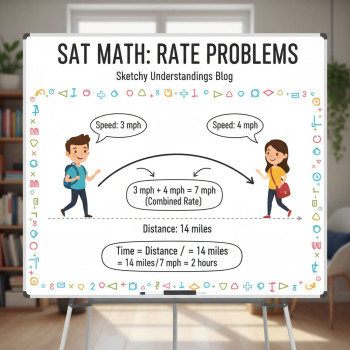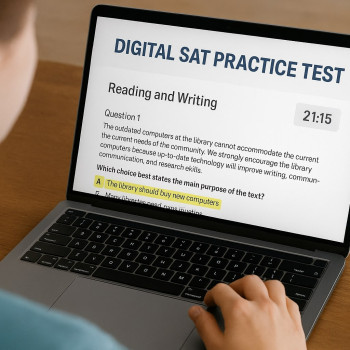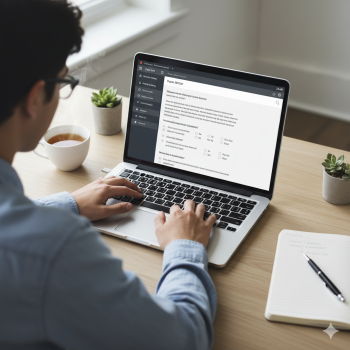Why data interpretation matters on the SAT (and in life)
When students hear “data interpretation,” many picture dry statistics or tedious spreadsheet work. But on the SAT, data interpretation is anything but boring—it’s a fast, practical skill that shows up across the test and rewards clarity, speed, and common sense. If you can read a table, pick apart a chart, and translate words into numbers, you gain an outsized advantage: fewer silly mistakes, faster pacing, and a sharper ability to eliminate wrong answer choices.
This blog is a friendly, practical guide for building those skills. We’ll walk through where data interpretation appears on the SAT, why it matters, concrete strategies that work during practice and on test day, and a realistic study plan. Along the way, you’ll see examples and quick drills you can start using tonight. I’ll also mention how Sparkl’s personalized tutoring and benefits—like 1-on-1 guidance, tailored study plans, expert tutors, and AI-driven insights—can fit naturally into this process if you want extra acceleration.
Where data interpretation shows up on the SAT
The SAT doesn’t have a separate “data” section. Instead, data interpretation is woven through both the Math test and the Evidence-Based Reading and Writing (EBRW) sections. You’ll meet data in a few common formats:
- Tables and spreadsheets: rows and columns of values you must compare or compute from.
- Bar charts, line graphs, and scatterplots: visual trends and slopes.
- Infographics and combined graphics: a chart next to a passage or question that tests reading comprehension plus numeric reasoning.
- Contextual word problems: everyday scenarios requiring calculation, unit conversion, or estimation.
How much of the Math section is data-focused?
On the Math portion, the College Board organizes questions into content domains. One of the central areas is Problem Solving and Data Analysis (often abbreviated PSDA)—this is the domain most directly linked to data interpretation. To give you a practical snapshot, here’s the typical distribution of content domains in SAT Math:
| Content Domain | Approximate Percentage of Math Questions |
|---|---|
| Heart of Algebra | ~33% |
| Problem Solving & Data Analysis (PSDA) | ~29% |
| Passport to Advanced Math | ~28% |
| Additional Topics (geometry, trig) | ~10% |
That PSDA slice represents almost a third of math questions—enough to change your score if you aren’t comfortable with charts, percentages, ratios, and interpretation. And remember: the EBRW sections can also include graphics tied to passages, so the impact of data interpretation extends beyond math.
Why students who read data well score better
Three big reasons explain why strong data interpretation skills translate to higher SAT scores:
- Efficiency: Data-savvy students translate graphics into calculations quickly, reducing time wasted puzzling over what the chart even means.
- Accuracy: Misreading axes, scales, or units is a common trap. Familiarity reduces those mistakes.
- Strategic elimination: When you can estimate or sketch a quick mental picture, you can often eliminate multiple answer choices without doing heavy algebra.
Concrete strategies you can use today
Below are practical, test-ready moves. Practice them so they become automatic.
1. Read the axes and units out loud
Before you dive into computations, pause and name the axes and units. If a line graph shows “Population (thousands)” vs. “Year,” saying that out loud forces you to keep track of scale. Many errors happen when students forget a multiplier (thousands, millions, dollars, minutes). A tiny note like “y is thousands” can change the correct answer.
2. Always scan for surfacing relationships
Ask: Is this a ratio question, a rate over time, or a comparison of categories? That initial framing tells you which mathematical tools help most—percent change, slope, median/mode, or proportional reasoning.
3. Round and estimate first
If answer choices are spread out (10, 25, 40, 100), a quick estimate often nails the correct zone. Estimation is one of the highest-leverage habits: it prevents lengthy algebra when simple reasoning will do. Practice rounding numbers to friendly values during practice tests so the habit is automatic.
4. Use the “one-variable test” for tables
If a table has multiple columns, isolate one variable and test how it affects the others. For example, if a table lists study hours and test scores for students, try to see whether score increases are roughly proportional to hours. That visual pattern can suggest the right algebraic setup quickly.
5. Watch for deceptive visuals
Graphs sometimes use non-zero baselines or uneven intervals. Look closely at tick marks—don’t assume they’re equally spaced or start at zero. The SAT loves to test whether you noticed those details.
6. Mark up the passage or graphic
On the EBRW sections, you’re allowed to write on the test booklet. Circle important numbers, cross out irrelevant legends, and draw arrows from labels to bars or lines. Physical annotation increases accuracy and confidence.
7. Translate words into a simple equation
Many PSDA problems are disguised algebra. Translate phrases like “twice as many” or “increased by 15%” into equations and keep them short. If the algebra looks messy, return to estimation or backsolve using the answer choices.
8. Backsolving and plugging in numbers
When variables make an expression abstract, try plugging in convenient numbers. If a question asks which value of x makes an expression equal, pick a friendly number for x and see which answer choice works. This is especially handy when answer choices are numerical.
Two mini walkthroughs: practice with real SAT-style thinking
Walkthroughs help make strategies concrete. The next two examples are short, SAT-relevant problems you can do mentally or on paper.
Example 1: Bar chart and percent change
Imagine a bar chart showing the number of bicycles sold in City A over three years: Year 1: 420, Year 2: 525, Year 3: 630. The question asks: “Between Year 1 and Year 2, what is the percent increase?”
Quick method:
- Compute the increase: 525 − 420 = 105.
- Divide by the original (Year 1): 105 ÷ 420 = 0.25.
- Convert to percent: 0.25 × 100 = 25%.
Tip: If the numbers are messy, round to friendly values. For instance, if the chart had 418 and 524, rounding to 420 and 525 makes the arithmetic manageable and the percent estimate still solid for answer elimination.
Example 2: Table and proportional reasoning (a common PSDA type)
Suppose a table lists production output of machines by speed settings: Low: 8 units/hour, Medium: 12 units/hour, High: 18 units/hour. If one machine runs Medium for 3 hours and High for 2 hours, how many units produced?
Compute directly:
- Medium: 12 × 3 = 36 units.
- High: 18 × 2 = 36 units.
- Total = 36 + 36 = 72 units.
Tip: Recognize symmetry. Here both periods yield the same production—an observation that can speed you to the answer without full arithmetic in some cases.
Common traps and how to avoid them
The SAT includes purposeful traps to test careful reading. Here are a few and how to sidestep them:
- Misreading the axis or category labels: Double-check what each axis represents before computing.
- Forgetting units: Convert units first. If one column is in thousands and another in single units, convert so everything matches.
- Assuming causation from correlation: If a passage presents two trends, the SAT often asks about relationships, not causation. Phrase your answer carefully.
- Ignoring baseline changes: If a graph changes scale mid-chart, recompute rather than eyeballing the difference.
How to structure your practice for maximum improvement
Deliberate practice beats hours of random problem-solving. Here’s a focused routine that builds both speed and accuracy.
| Week | Focus | Suggested Time per Week |
|---|---|---|
| 1 | Foundations: units, percentages, ratios, reading axes | 4–6 hours |
| 2 | Charts and tables practice; simple estimation drills | 4–6 hours |
| 3 | Timed sections focused on PSDA questions | 5–7 hours |
| 4 | Mixed practice with EBRW graphics and Math PSDA | 5–7 hours |
| 5 | Full practice tests with targeted review (annotate every data question) | 6–8 hours |
| 6 | Weak-point drilling and strategy refinement (estimation, backsolve) | 6–8 hours |
This plan gives you a concrete six-week push. If you have more time, stretch each phase to deepen mastery. If you need to compress, prioritize weeks 1–3 and do more targeted reviews in weeks 4–6.
How Sparkl’s personalized tutoring fits into data interpretation practice
Many students benefit from a coach who spots recurring mistakes and adjusts the plan—this is exactly where Sparkl’s personalized tutoring shines. Here’s how targeted coaching can help:
- 1-on-1 guidance to identify whether estimation, axis-reading, or translation from words to equations is the real bottleneck.
- Tailored study plans that focus your practice on the specific data formats you struggle with (tables, scatterplots, percent-change problems).
- Expert tutors who model annotation and decision-making during walkthroughs so you internalize best practices faster.
- AI-driven insights that track patterns in your mistakes—so tutoring sessions are efficient and focused.
If you want to accelerate, a few targeted sessions that simulate test conditions and analyze errors can compress months of progress into weeks.
Real-world value: why data interpretation matters beyond the SAT
Think beyond the test. Employers, college courses, and everyday life reward people who can read numbers quickly and make sound judgments. You might use the same skills to:
- Compare scholarship offers or college cost estimates.
- Analyze a lab result or a science fair dataset.
- Interpret polls, infographics, or news articles with charts.
So practicing data interpretation for the SAT builds a transferable, high-value skill.
Quick drills to practice right now (10–20 minutes)
Here are short drills you can do anywhere—no full test required.
- Find a news article with a chart. Identify the variables, scale, and any non-zero baseline. Summarize the main trend in one sentence.
- Create three percent-change problems from random numbers on a flyer or menu (e.g., price changed from $8.50 to $10.20). Solve them by hand and check your work.
- Open a practice SAT Math set and time yourself for a five-question PSDA block. Mark what slowed you down and focus next practice on that skill.
When to slow down and when to sprint on test day
Good pacing matters. Use this rule of thumb during the SAT:
- If a data question can be estimated or solved by quick arithmetic, do it immediately.
- If it requires messy algebra, try backsolving from the answer choices or plug in a friendly number to simplify.
- If you’re stuck for more than a minute and the question is worth the same as others, mark it and move on—return with fresh eyes if time allows.
Final thoughts: turn small gains into big score jumps
Data interpretation is a high-return area of SAT prep. A few targeted habits—reading axes, estimating, and practicing PSDA problems—can convert uncertainty into confident, fast answers. Because data interpretation appears across the SAT, improvements here compound: better accuracy in Math, sharper comprehension in EBRW, and smarter time management overall.
If you want guided help, Sparkl’s personalized tutoring can be an excellent complement to your independent practice. Short, focused tutoring sessions that concentrate on your trouble spots—annotation, translating words to equations, or estimating under pressure—often produce visible score gains faster than unguided drilling. Whether you choose self-study or coaching, the key is deliberate, consistent practice.
One-week checklist to get started
Follow this checklist to start turning data interpretation into a strength:
- Complete three PSDA practice sets and annotate every data question.
- Do two estimation drills (percent change, rate problems).
- Annotate one EBRW passage with a chart and summarize it in a sentence.
- Review errors and decide whether they’re conceptual or careless; plan one fix for each.
- If stuck on a recurring pattern, schedule a short 1-on-1 review to target that weakness.


Data interpretation is less about raw computation and more about habits: careful reading, smart shortcuts, and pattern recognition. Practice those habits, and the SAT will stop being a guessing game and start feeling like a system you can understand and beat. Happy studying—and remember, small daily improvements add up to big score changes.




















No Comments
Leave a comment Cancel